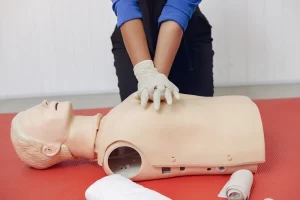


Injuries and accidents strike without warning and can lead to several problems if you don’t have a first aid kit around. Accidents happen all the time at home, in the workplace, or at school.
A minor mishap can become severe if you don’t have a first aid kit around. In some cases, the presence of a first aid kit has saved the lives of many individuals.
Regardless of the benefits it offers, the significance of the first aid kit is well-known to all. However, what is the point of having a first aid kit when you don’t have the skills required for using it? Many organizations offer specific first aid courses that help people handle medical emergencies better.
While the courses are helpful, this blog will provide the necessary details on using a first aid kit.
First aid is primary and immediate medical care; it is the best way to treat minor injuries and conditions. It should be provided to a person who is injured or ill until full medical treatment is available.
First aid is a great way to deal with minor injuries such as burns, cuts, or insect stings. However, people are often unaware of its significance in ensuring the patient’s well-being until proper care arrives.
You can face different forms of medical emergencies. Sometimes, an emergency occurs due to external events; in other cases, the reason is internal.
In cases where the matter seems internal, all you can do is provide care and stick around with the affected person. Covering them with a warm blanket helps in most cases and ensures that the patient is calm. If you are aware of the medical condition that the person suffers from, provide them with care according to the situation.
The scenario changes entirely in the case of an injury related to an accident. The first part of providing relief requires ensuring that everything around you is safe. You must be alert and look for signs of falling debris or a violent mob.
If you feel that the situation is beyond your control, get to a safe place and call for professional help. However, you need to take the initiative even if the location is completely secure. Assess the person affected and avoid moving them until they are away from danger.
Stick with the person and use available resources to tend to their needs. In the meantime, tell the people around you to call for medical help or dial the local emergency number.
Stay with the person until medical help arrives. You need to ensure that your presence leads to calmness. You can save a person and avert the injury with the help of simple first aid tips.
While relieving the patient, you must be alert to the situation. Move away from the location if you feel imminent danger from the situation around you.
Here are some of the medical procedures you can carry out in the case of a medical emergency.
A bandage is required to keep a dressing in place. The product helps in controlling the bleeding of the patient. You can also apply the procedure to support a limb or raise it to reduce the swelling.
There are two main types of bandages that you should have in a first aid kit. The first is the roller bandage. This type of bandage is used to treat injured limbs. It holds dressings and helps support ankles, knees, wrists, and elbows.
Another bandage you can find in a first aid box is the triangular bandage. These bandages are for large dressings and are primarily used as slings to support a wrist, arm, or shoulder injury. You can fold the bandage in a broad fold to prevent the limb from moving.
If, for some reason, there is no bandage, you can always improvise and look for other options. A piece of clothing or material such as a headscarf can work great as a bandage. The equipment can provide relief in case of an accident.
Joint injuries are the most common type of injury. Although this type of injury can seem tricky, it is easy to deal with if you know how to apply the bandage and have the first-aid kit to help you.
The following steps will help you apply a bandage to the affected area:
Another practice in that area is CPR. Knowing CPR can help you save lives; even if you are not well-versed with the method, you can use it to help an unconscious person.
You can use the hands-on CPR approach to keep the affected individual alive until professional medical help is available.
Call 911 as soon as you see someone collapse to the floor or lying unconscious. Approach the affected person cautiously and ensure the area around him or her is safe. After securing the area properly, perform CPR until professional help is unavailable.
Hands-only CPR approach is one technique that even unskilled individuals can use for CPR. The method is relatively easy to learn and keeps a patient alive until professional help is available.
Here is how you can use hands-on CPR to save a life:
A bleeding nose is something that we all come across. Here are tips that you can use to manage the nosebleed:
You never know when first aid may come in handy. From road accidents to minor injuries at home, a first aid kit can be a lifesaver on any given day. The kit can also help avoid a trip to the hospital in case of minor injuries.
You can purchase pre-assembled first aid kits from first aid organizations. Another thing that you can do is to create a first aid kit of your own by purchasing essential products from a nearby pharmacy.
You can create a first-aid kit by including the following elements:
You need to be cautious when dealing with emergency cases. Don’t forget to prioritize your safety instead of being a hero and risking it all. You need to be vigilant and check for hazards that can put your life in danger.
Wear the protective gear necessary to deal with an emergency to avoid contact with blood, vomit, and other bodily fluids around you.
Basic First Aid can help prevent a minor situation from worsening and even help you save an individual’s life. Not everyone is a medical expert, but we can all play a role in creating a safe environment around us.
Look at our available classes if you’d like professional training to learn first aid skills and earn a 2-year first aid certification card. We’re conveniently located in Vacaville, California, but we can train at your location for groups of 6 or more.